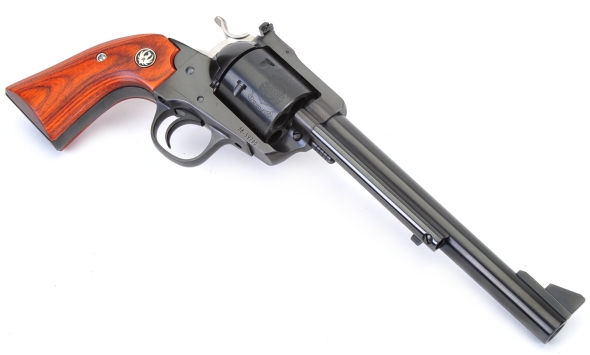
Post a message expressing appreciation for the 45 Colt cartridge on social media and someone will soon reply with “Too bad there is no ammo for it”, which suggests the person is permanently attached at the butt to a Lazy Boy or is living in a dorm and never owned a firearm. There are fifty three common factory loads for the 45 Colt from original slo’ mo’ cowboy to good grief hunting loads, all within the grasp of anyone who how to put items in a digital shopping cart.
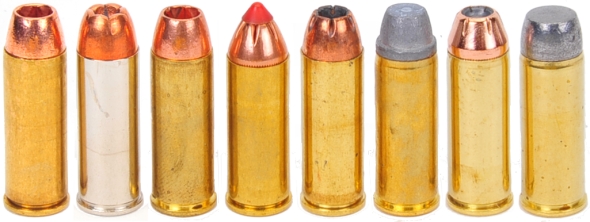
| Ammunition | Pressure | Bullet Type |
Bullet Weight Grains |
Rated Velocity FPS* |
Recorded Velocity FPS |
25 Yard 3 Shot “ |
| Barnes Vor-Tx | Standard | Leadless HP | 200 | 1025 | 1077 | 2.8 |
| Winchester PDX1 Defender | Standard | JHP | 225 | 850 | 867 | 2.1 |
| Corbon DPX | +P | Leadless HP | 225 | 1200 | 1216 | 2.4 |
| Hornady FTX | Standard | Poly Tipped | 225 | 950 | 902 | 1.9 |
| Remington High Terminal Performance | Standard | JHP | 230 | 850 | 892 | 2.3 |
| Buffalo Bore Heavy Colt | Standard | Lead Cast | 255 | 1000 | 1019 | 3.0 |
| Buffalo Bore Heavy Colt | +P | JHP | 260 | 1450 | 1524 | 2.5 |
| Grizzly | +P | Lead Cast | 265 | 1400 | 1297 | 2.4 |
| *Manufacturers’ Listings | ||||||
The ammo pictured above left to right, listed top to bottom represent a central core of factory ammunition. There are many other types like Liberty Civil Defense 78 grain ammo with 1800 fps muzzle velocity, or 360 grain hard cast lead +P from Doubletap with a muzzle velocity of 1200 fps. In my narrow frame of reference, single action revolvers are great for hunting back up and trail carry, but I do not use single action revolvers routinely for concealed carry. Subsequently, light self defense loads were omitted. I also think there is a line where the Colt taps out and the 454 Casull takes over and I tend to see the 454 as an overkill in all but extreme situations.
A hard cast 255 – 260 grain slug at 1450 fps will hole punch a deer and kill with the wound channel left behind a non-expanding bullet. The results are pretty much the same for hogs and this type of load is more than enough for black bear. Driving a 360 grain non-expanding hard cast bullet to do the same would be no more lethal. If I were planning to hunt Alaskan moose or brown bear, I would skip hot loading the 45 Colt and head for the 454 Casull, 475 Linebaugh, or 480 Ruger which are available in a similar compact single action package, either in factory or custom form.
Based on bullet weights and velocity ratings listed by manufacturers of most +P factory ammunition, pressure levels of 28,000 PSI to 30,000 PSI would seem to apply. What is missing from that rating, when it appears on factory boxed ammo, is a SAAMI +P specification. There are +P ratings for some cartridges like the 9mm Luger, 45 Auto, 38 Special, and 38 Super, there is no +P spec for the 45 Colt. Consequently, 14,000 PSI maximum average pressure is the only maximum pressure spec for that cartridge and anything labeled +P is arbitrarily assigned and complied with by the individual manufacturer. While that may seem a bit flimsy in instilling confidence in the shooting public, the burden of business success or failure and product liability tends to make manufacturers exercise an abundance of caution.
For folks who can’t leave well enough alone…
Part 1 of “Ruger’s Bisley Blackhawk 45 Colt” addressed the power potential of the 1872 45 Colt cartridge in concert with modern strong firearms and modern components. The Bisley Blackhawk is built on a large frame, the same as used for Super Blackhawk production and the same size cylinder. It is not the same, however, as the Bisley Super Blackhawks chambered for the 454 Casull and 480 Ruger, which are made from more specialized materials and subjected to different manufacturing processes to withstand the pressure of these cartridges.
Most mainstream handloading break 45 Colt data into two sections, one near original Colt SAA designs and another for firearms with robust designs; Ruger’s Blackhawks and Redhawks, Freedom Arms, Thompson Center and similar. Most reloading manuals do not specify pressure levels, but where they do, as by Western Powders, they max out at 30,000 PSI for Ruger class loads. Looking at data across a number of reloading manuals, there is inference that 30,000 PSI is a universal ceiling for this category of Colt 45 handload. Transducer and strain pressure checking of handloads assembled following the higher performance data suggests the same.
A great deal of specialized Ruger handload development work was done by people like John Linebaugh. His article “The .45 Colt, dissolving the Myth, Discovering the Potential” offers credible information that includes H.P. White Laboratory destructive test data and the author’s interpretation of results. Linebaugh concluded that the Ruger Blackhawk is good for loads up to 32,000 CUP, which reasonably tracks to published handload data for stout firearms.
PSI? CUP? Doesn’t much matter if you can’t read it
The problem with technical data and specifications for handloaders is that there must be a meaningful way to monitor those indicators during load development for them to be useful. So you break out your universal receiver and test barrel, grab ammunition manufacturers’ calibrated copper test slugs… which you will not be able to get as few test in CUP anymore. So you grab a certified test barrel, conformal transducers, charge amplifier and high speed scope and calibration ammunition or calibration equipment and check for PSI… which is not the same as CUP… and no number of high school physics teachers can correctly provide a legitimate conversion from CUP to PSI.
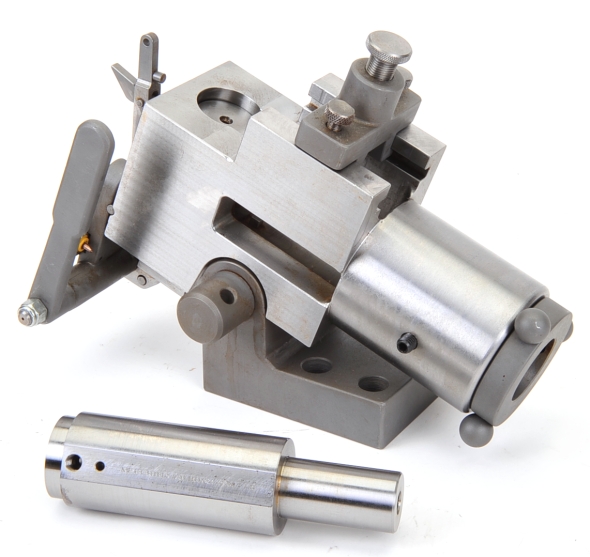
We use transducer and strain technology in the shop for popular cartridge, long term handload development. Unless done routinely and cooperatively within the industry, transducer methodology is expensive, arduous and fraught with anomalies. Strain is much simpler, must less costly and just as effective in keeping fingers and face intact when combined with careful adherence to well documented handloading procedures… that section in all mainstream reloading manuals that too many people skip over to get to load data pages.
While firearm mounted strain gauge methodology, while a simpler method of checking pressure, will not work with some cartridges and some firearm configurations. Elements like exceptional barrel diameter, gauge placement relative to chamber, gauge bond to surface metal, and gauge orientation all impact validity of readings. Moving assemblies make revolvers and autoloaders problematic using strain, so we tend to have single shot barrels made for these cartridges, wire them, and mount them to a TC frame for use as a test fixture. In other cases we use a Ruger No.1 action in concert with a variety of test barrels.
The cost for a universal receiver based system and set up for one cartridge easily exceeds $15,000. The ability to test additional cartridges, test barrel and conformal transducer is approx $1,500 per on a good day. The cost of a reasonable strain gauge based system is approximately $1,000 for equipment and software and approximately $30 per firearm to be tested. This does not include the cost of the test firearm and other related equipment. With either approach, and developed experience, it would be possible to know where in the pressure spectrum your handloads fall.
There are a number of predictive software products out there, free and commercial, that estimate pressure, based upon components used and dimensions of assembly. They are helpful as a sanity check when used in concert with valid data, but they are not useful for much else. Anyone who has used them knows that chronograph results can vary from calculated projections by as much as 25% and pressure levels by a similar amount or even more. The calculations are predicated on component spec data with a static view of bore friction, temperature, primers, etc. In the real world, powder energy varies from lot to lot, chambers and bores vary in dimension and even primer brand selection influences pressure.
Unless there is a reason to blaze new trails, the safest way to handload for your own firearms is to work from mainstream reloading manuals. Most are the work of component manufacturers. They have the information and resources to allow you to get the most out of your firearms when handloading and to keep you safe. Just read the cautions, follow the assembly checks and instructions, start with minimum loads, work up as needed, monitoring progress as defined.
45 Auto bullets Vs 45 Colt bullets
The SAAMI spec for a jacketed 45 Auto bullet is 0.4520″ + 0.0000″/-0.0030″, 0.4530″ +0.0000/-0.0030″ for lead. The SAAMI spec for the 45 Colt, with no lead or jacketed bullet differentiation is 0.4560″ +0.0000″/-0.0060. Bullets for either are sold as 0.451″ or 0.452″ with jacketed bullets biased toward 0.451″ and cast bullets toward 0.452″. What mostly separates 45 Auto bullets and 45 Colt bullets is weight. Traditional type bullets for both, jacketed or lead, generally start at 185 grains. However, the 45 Auto generally stops at 230 grains, occasionally 250, but the 45 Colt can go beyond 360 grains in cast form. The weight differences are consistent with the powder charges and operating pressure of each cartridge.
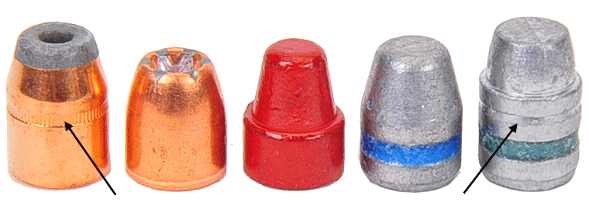
How do we know which 45 caliber bullets are which? Cannelures. The 45 Auto is a rimless cartridge that headspaces on its case mouth. The 45 Colt is a rimmed cartridge that headspaces on the rim. The Auto gets a tapered crimp while the Colt gets a rolled crimp that requires a groove in the bullet to receive the rolled case as signified with arrows, above.

| Bullet | Type | Bullet Weight Grains |
Bullet Length “ |
Crimp |
| Sierra Sports Master | JHP | 240 | 0.641 | 0.350 |
| Nosler Sporting | JHP | 250 | 0.677 | 0.360 |
| Oregon Trail | Solid | 255 | 0.691 | 0.370 |
| Speer | JHP | 260 | 0.680 | 0.390 |
| Oregon Trail | Solid | 300 | 0.797 | 0.410* |
| *0.500 deep seat crimp groove | ||||
All of the bullets are tough and work well with elevated 45 Colt velocities. The 300 grain is longer than spec when assembled using the shallow seating crimp groove, but there is plenty of room in the Ruger Bisley Blackhawk’s cylinder and charges were adjusted to suit the increase in net case capacity.
While shuffling through brass, I had to pull all once fired Hornady brass. Trim to case length for the 45 Colt is 1.275″, however, Hornady brass measures 1.235″ to accommodate their unique FTX bullet. The too short 0.040″ means either a traditional bullet is seated out and misses the crimp groove, or the bullet is seated to the cannelure and net case capacity is reduced. The result of the latter is that pressure with standard load data will be higher than anticipated. I went with Starline brass, which measured 1.280″ and left a little room for clean up trimming to 1.275.

An hour of Youtube 50’s & 60’s rock & roll…
I am not sure if Buddy Holly, Little Richard, Chuck Berry, and Eddie Cochran make for a good reloading session play list, but it certainly moved the pace along. I confess to not remembering that Huey Smith & The Clowns performed “Don’t You Just Know It”, but I figure most of you are drawing a blank on the others as well. When the 60’s songs started playing, I got to wondering how to convince my wife we should start a project car with the objective of getting on the Street Outlaws Top 10 list. Maybe a topic for the dinner table? Maybe not? Anyway…
With precision measurements in hand, reloading ensued. Things changed during assembly as they often do and some COL dimensions were adjusted accordingly. H110 powder was selected and Lil’ Gun, my original thought, was put aside to take advantage of the H110 flatter pressure curve. They came out looking like this Left to Right, on the table below Top to Bottom –
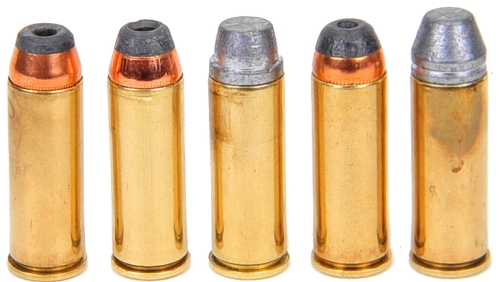
 |
Warning: Bullet selections are specific, and loads are not valid with substitutions of different bullets of the same weight. Variations in bullet material and length will alter net case capacity, pressure and velocity results. Primer selection is specific and primer types are not interchangeable. These data represents maximum loads in our firearms and test equipment and may easily be excessive in other applications. All loads should be reduced by 3%, and developed following safe handloading practices as represented in established reloading manuals produced by component manufacturers. Presentation of these loads does not constitute a solicitation for their use, nor a recommendation.
|
||||||||||||||||||||||||||||||||||||||||||||||||||||||||||||||||||||||||||||||||
|
|||||||||||||||||||||||||||||||||||||||||||||||||||||||||||||||||||||||||||||||||
Well there you have it…
Without going to the pressure and recoil extremes of the 454 Casull or both of those and huge handgun size to get to the 460 S&W, the Ruger Bisley Blackhawk offers a lot of power, while remaining manageable enough to shoot accurately. Factory ammo performed admirably, most producing as advertised and some a little bit more. The handloads produced good power, without being on the edge. No stuck cases, no blown primers, comfortable to shoot and accurate. The Bisley grip and long sight radius made big contributions to the effort. It is a combination that could be shot heavily for a life time.


Email Notification